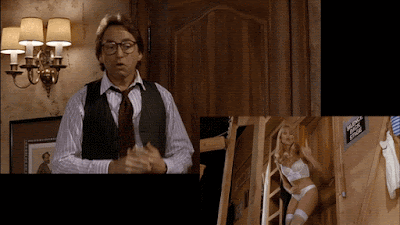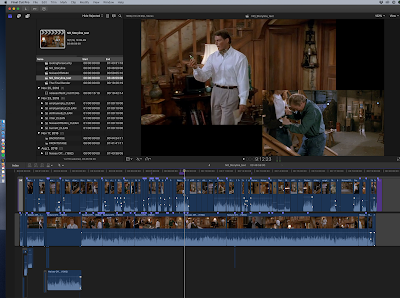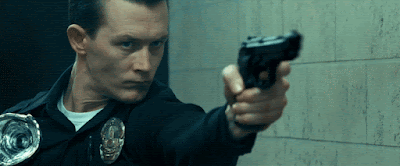As a rabid admirer of “Noises Off...”, the irreverent 1992 film adaptation of the hit stage play, I always wondered how precisely the first act of the film (which depicts the first act rehearsal of a play) would synchronize with the second act of the film (which depicts a performance of that first act, but from the backstage perspective). So I did my best to
synchronize the two sections of the film, so here it is: a single 19 and a half minute take of act one of 'Nothing On.'
Two Views of "Noises Off..." on Vimeo.
The stage play of “Noises Off...” is performed first with the ‘Nothing On’ (the play-within-the-play) set facing the audience, and then with the set spun 180 degrees so the audience can see all of the backstage antics. Film director Peter Bogdanovich took the same approach with the movie, with the camera largely remaining on the ‘audience’ side of the set during act one of the movie. For act two of the film, the camera largely remained backstage, with only occasional audience-perspective cutaways.
My approach for my synchronization edit was fairly straightforward. My first task was to create an uninterrupted “take” of the dress rehearsal performance, photographed from the audience view. This meant editing out all of the interruptions from act one of the film, mostly consisting of the director Lloyd Fellows (Michael Caine) bellowing to his actors about sardines continuity, providing motivation for his actors, and looking for Brooke’s lost contact lens.
Once that uninterrupted performance was edited together, I took the backstage-perspective (act two of the film) and cut it so it would be in sync with that audience-perspective performance. This proved to be the bigger challenge, since the backstage antics revolve around the characters’ mischief that nearly sabotages the play many times.

For the backstage edit, I did a few retimes (both speedups and slowdowns) and did my best to synchronize the lines of dialogue. Remarkably, the backstage portion of the film is fairly true to the rehearsal, with a few large gaps where moments of the script were simply not represented. For these giant gaps, I decided to fill the backstage edit with “clean” shots - backstage shots without any characters in frame. I got away with a few choice still frames, but had to create three “clean” plates, painting out John Ritter, Marilu Henner and Carol Burnett out of three different shots. I didn’t want to over use the backstage security guard reactions, gloriously portrayed by J. Christopher Sullivan, since it would quickly appear repetitive.
As the second act rolls on, the backstabbing and sabotage becomes much more disruptive to the performance of “Nothing On”, which was hard to obscure in the edit. Near the end of the edit, I had no choice but to show the massive discontinuities between the near-perfect rehearsal and the mayhem of the performance. I kept the main timing of the major beats (entrances, exits, sound cues) intact, however, as much as I could.

My editing process was quite straightforward. The play within the movie is a farce which luckily contains several slamming doors—the perfect synchronization device. After I edited the dress rehearsal footage into an uninterrupted version of the play, I grabbed the backstage footage and started synching door slams. Once I bracketed a section of footage, bookended by door slams, I looked at the clip and gently retimed or edited the chunk so that the lines of dialogue overlapped. Frequently I’d have a version of the “backstage” dialogue at a low gain, so you can hear a bit of an echo. I ended up with around 140 cuts.
The film (and the play on which it’s based) is remarkable at how it weaves the lines and actions of ’Nothing On’ with the back. I particularly love the synchronized backstage and in-play “Oh my God!” outburst from Christopher Reeve.
Another nice moment is John Ritter’s in-play line “He’s searching for something!” which synchronizes nicely with Michael Caine searching Denholm Elliot for the missing bottle of booze.
Editing all of this "Noises Off..." footage together gave me even more respect for the technical craftmanship of the screenplay, choreography and performances of the film. Not nearly enough platitudes can be given to Ritter, Henner, Burnett, Caine, Elliott, Julie Hagerty, Mark Linn-Baker, Reeve and Nicollette Sheridan for their remarkable, distinctive performances and dedication to these highly technical roles.























































